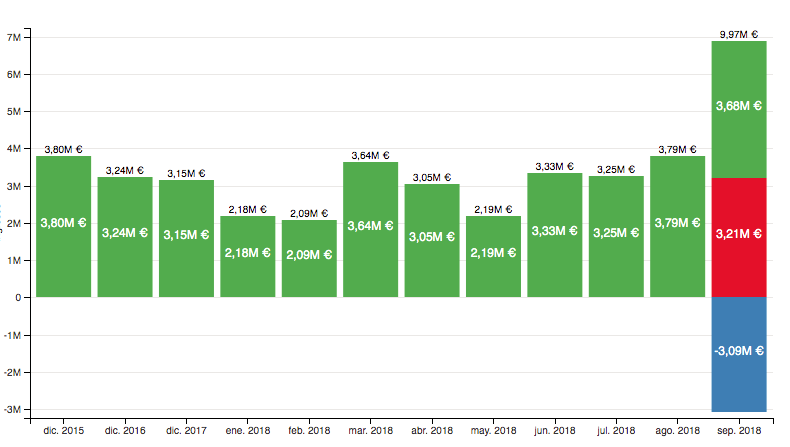-
Notifications
You must be signed in to change notification settings - Fork 1.8k
New issue
Have a question about this project? Sign up for a free GitHub account to open an issue and contact its maintainers and the community.
By clicking “Sign up for GitHub”, you agree to our terms of service and privacy statement. We’ll occasionally send you account related emails.
Already on GitHub? Sign in to your account
Stacked Bar Chart with both positive and negative groups #1207
Comments
|
I don't know of a current solution for bar charts, but #1068 presents something similar for row charts (which don't have stacking, but if you only have one positive and one negative stack it's the same thing). |
|
Apparently d3.stack supports this through stack.offset: https://bl.ocks.org/mbostock/b5935342c6d21928111928401e2c8608 Haven't tried this with stackMixin.stackLayout – anyone can help out by giving this a shot and reporting back here. |
|
Or rather, it's part of d3v4 now. d3/d3-shape#96 |
|
Hi everybody, |
|
I found a better way, instead of "iterate" use variable x and check if the d.x is a new value of a repeated: |
|
I tested a bar graph with stackOffsetDiverging, calling chart.stackLayout(d3.stack().offset(d3.stackOffsetDiverging));To make it work it is necessary to make some adjustments:
chart.on('renderlet.internal', (chart) => chart.selectAll(".bar").attr('y', (d) => chart.y()(d.y1)));
chart.yAxisMin = () => {
const flattenStacks = Array.prototype.concat.apply([], this._dcChart.data().map((layer) => layer.domainValues));
return dc.utils.subtract(min(flattenStacks, (p) => p.y0), this._dcChart.yAxisPadding());
};
chart.yAxisMax = () => {
const flattenStacks = Array.prototype.concat.apply([], this._dcChart.data().map((layer) => layer.domainValues));
return dc.utils.add(max(flattenStacks, (p) => p.y1), this._dcChart.yAxisPadding());
};These modifications do not affect the behavior of the chart with the default stack. If a renderlet is used to modify the chart, it is important to first define the listener that modifies the In my case for example I define a renderlet to add some labels in each bar and I must execute it with the correct I have not yet been able to verify why, but I have seen that if I hide all the stacks except the one with negative values, the height of the bars is not calculated correctly, it is zero. I have used this example as a reference: https://bl.ocks.org/mbostock/b5935342c6d21928111928401e2c8608 |
|
Thanks @frankisans, that's helpful info. TBH I am kind of surprised that it works as well as it does, given that the stack mixin was never designed to work with the new stack layouts. I take it you are saying that these changes could be pulled in without breaking the original stack functionality. That would be nice! If so, maybe someone could create a PR with tests. |
Do you have any angular code for this on stackblitz? |

Hi,
Is it possible to correctly display a stacked bar chart when you have to stack both negative and positive groups?
The problem is well described here https://groups.google.com/forum/#!topic/dc-js-user-group/CjGLKECU1II and the author provides a solution, but for 1.3. I wonder if anyone has done the same for 2.0? or if anyone could point me into right direction?
The text was updated successfully, but these errors were encountered: